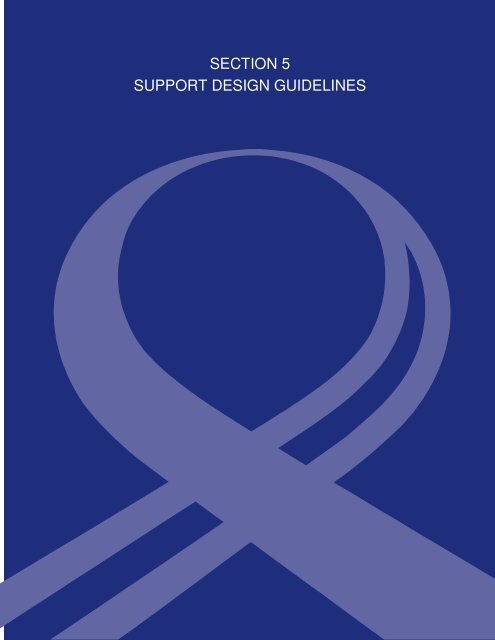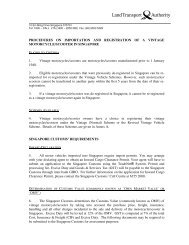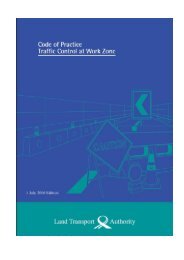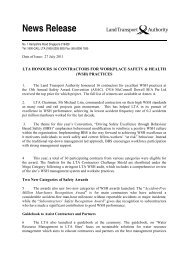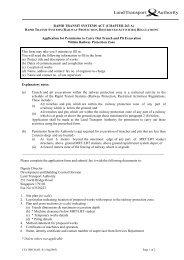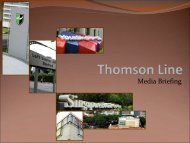ADC Section 5 - Support Design Guidelines - Land Transport Authority
ADC Section 5 - Support Design Guidelines - Land Transport Authority
ADC Section 5 - Support Design Guidelines - Land Transport Authority
- No tags were found...
You also want an ePaper? Increase the reach of your titles
YUMPU automatically turns print PDFs into web optimized ePapers that Google loves.
SECTION 5SUPPORT DESIGN GUIDELINES
Architectural <strong>Design</strong> Criteria : <strong>Section</strong> 5<strong>Support</strong> <strong>Design</strong> <strong>Guidelines</strong>CONTENTSTitle Rev. Date5.1 NOT AVAILABLE FOR DOWNLOAD - -5.2 Guide to the Layout of The Tactile Guidance System in MRT and A1 July 09LRT Station5.3 Glazing <strong>Design</strong> Handbook A1 July 09Jul 2009Architectural <strong>Design</strong> Criteria – Revision A1
Architectural <strong>Design</strong> Criteria : <strong>Section</strong> 5.2Page-1/33Guide to the Layout of The Tactile Guidance System inMRT and LRT StationsCONTENTSBasic Tactile Tile Indicators 2TACTILE ROUTE 3At Typical elevated Station 4At Typical Underground Station 6STANDARD DETAILS 9At Station Entrance 10At Junctions – 3 Ways 11At Junctions – 90 degrees 12At Special Junctions 13At Platform Level – 3 Cars 14At Platform Level – 6 Cars 15At Platform with PSDs 16At Platform without PSDs 17At Concourse Level 18At AFC Wide Gate 20At PSC 21At Lift 23At Disabled Toilet 25At Staircases/Escalator 26At Ramp 27At Edge of Road Kerb 28At Auto Door Without Ramp 29At Auto Door With Ramp 30Homogenous Tactiles 31Granite Tactiles 32Stainless Steel Studs Inserts 33Jul 2009<strong>Section</strong> 5.2 of Architectural <strong>Design</strong> Criteria – Revision A1
Page-2/121 INTRODUCTIONGlazing: The complete element of construction comprising the glass, the fixing or frame , gaskets, siliconesealants and tapes.This handbook is intended to aid designers in choosing the most suitable glass and glazing system for usewithin buildings serving Singapore’s Rapid Transit Systems.The correct choice of a glazing system depends on an understanding of :-- The performance of the various types of glass currently available in Singapore.- The effects that the system of glazing have on this.- The dangers inherent in the location in which the glass is used.- The dangers inherent in the size of the glazed panels.- The load on the glazing- The consequences should the glass break.This handbook is intended to be read in conjunction with the following documents:-- The <strong>Authority</strong>’s Glazing Criteria.- The Architectural Materials and Workmanship Specification: ‘Glazing’.- The Civil <strong>Design</strong> Criteria.The <strong>Authority</strong>’s Glazing Criteria take the form of a series of performance requirements together with glazingrecommendations which, if followed, will ensure that the <strong>Authority</strong>’s requirements are met. <strong>Design</strong>ers will berequired to demonstrate that the performance of any proposed alternative systems will either equal, or surpass,the <strong>Authority</strong>’s requirements.Standards referred to in this handbook include:-- SS 341:1989: Safety glazing materials for use in buildings (human impact considerations)- BS EN 1863: 2000 Glass in building – heat-strengthened soda lime silicate safety glass: definition anddescription.- BS 952.1: 1995 Glass for glazing, classification.- BS 5368 Part 1: Air permeability test.- BS 5368 Part 2: 1980 (1986) Weather-tightness under static pressure.- BS 5368 Part 3: 1978 (1985) Wind resistance tests- BS 6262: 1982 B.S. Code of practice for glazing for buildings- ASTM C1036: 1997: Standard specification for flat glass- ASTM C1048: 1997: Standard specification for heat treated flat glass-Kind HS, Kind FT coated and uncoatedglass (note :HS = heat strengthened, FT = flat tempered)- ASTM C1172: Standard specification for laminated flat glass- European draft standard prEN 12337: includes chemically tempered glass. Part 2 defines laminated safetyglass, part 3, laminated glass.- European draft standard prEN 14179; Heat soaked thermally toughened soda-lime silicate safety glass.- European draft standard prEN 1096 Parts 1-4 defines and classifies various applications in terms of thedurability of coatings on glass.- German standard DIN 52290: refers to anti-vandal and anti-intruder tests on glass.- German standard DIN 18361: refers to polished wired glass.- German standard DIN 52290: refers to anti-vandal and anti-intruder tests on glass, and categorises glassaccordingly.- German Standard DIN 18516 Part 4: refers to heat soak tests on tempered glass.July 2009<strong>Section</strong> 5.3 of Architectural <strong>Design</strong> Criteria – Revision A1
Page-3/122 GLASS TYPES2.1 IntroductionGlass manufacturers produce various types of glass to meet differing performance requirements. Theclassification and description to be adopted for each is given in BS 952:1 unless noted below.2.2 Annealed Glass:Annealed glass may also be known as ‘float’ glass so called because it is floated in its molten state on a bath ofliquid metal, usually tin, and allowed to cool. The process produces glass which has a naturally polished finish,is flat, and capable of being manufactured to a uniform thickness.Annealed glass can be coloured during the manufacturing process.By careful choice of materials it is possible to reduce, or virtually eliminate the natural ‘green’ colour ofannealed glass. In such cases the glass is known as low-iron, or clear white glass, and its use is essential insituations when critical colours are to be viewed through the glass.Annealed glass breaks into large jagged shards with numerous small splinters. On breaking there is asignificant risk that large pieces of glass will fall from the frame and, as a result, the <strong>Authority</strong> does notencourage its use within stations other than as a constituent in laminated glass.Because of its breakage pattern, annealed glass is not considered a safety glass.Annealed glass is described in ASTM C1036: 1997: Standard Specification for Flat Glass2.3 Tempered glass (also known as toughened glass):Tempered glass is considered a safety glass because of its higher bending strength and fracture pattern. Whenused in locations where public safety is critical, the <strong>Authority</strong> will require it to comply with SingaporeStandard 341.All references to tempered glass in this Handbook are references to glass which will meet the requirements ofSS 341.Tempered glass is produced by heating annealed glass to approximately 650 o C and then cooling the outersurfaces rapidly using jets of cold air so creating high compression forces within them. This increases thestrength of the glass by a factor of four or five times that of annealed glass. To date, it has not proved possibleto cool both surfaces of the glass equally and, as a result, all tempered glass is subject to significant bow andwarp distortion.Tempered glass cannot be worked after the heat treating process is complete. This would inflict damage on thecompression layers on the surface of the glass, reduce their strength and affect the balance between them andthe inner tension layer such that the glass would shatter.Tempered glass breaks into numerous small pieces whose edges are generally blunt. There is, however, atendency for these to clump together on fracture and they may fall from the glazing in interlocking clumpsseparating only when they strike an object in their path. Because of this it has been recommended practice inthe U.K. since the early 1990s, not to use tempered glass in overhead glazing situations as either a single paneor the inner pane of a double-glazed unit. Neither is it recommended that it should it be held as a single pane ina point fixing system. The abrupt failure of tempered glass due to impurities such as nickel sulphide (NiS) isgenerally described as ‘spontaneous shattering’ or ‘spontaneous breakage’. The former term is used throughoutthis handbook and it is discussed in detail in section 5.4.While tempered glass complying with the requirements of SS 341 is intended to resist the impact of a personstriking it, it is important that the supporting structure and method of glazing is capable of taking the sameload.During the tempering process the glass can be held vertically by tongs, or carried horizontally by rollers. Thelatter is a more common and faster process. It eliminates tong marks but introduces a distortion known as‘roller wave’ as the glass passes across the rollers. Australia’s NATSPEC specification requires as a maximumdeviation for flatness, that any peak in the wave shall not exceed 0.15 mm. Tempered glass should be installedsuch that the orientation of ripples throughout the works is constant.Because of its strength, tempered glass is essential where glass is either point fixed or suspended.Tempered glass is described in ASTM C1048: 1997: Standard Specification for Heat Treated Flat Glass-KindHS, Kind FT Coated and Un-coated Glass.2.4 Heat strengthened glass:Heat strengthened glass is produced by heating annealed glass to a slightly lower temperature, 620 o C, andsubjecting it to a slower cooling process. The glass is generally twice as strong as annealed glass and has lessbow and warp distortion. Its breakage pattern resembles that of annealed glass except that only radial fracturesfrom edge to edge occur upon breaking. Like tempered glass it cannot be worked after the heat treating processis complete.July 2009<strong>Section</strong> 5.3 of Architectural <strong>Design</strong> Criteria – Revision A1
Page-4/12The production of heat strengthened glass demands much greater control of oven temperatures and thesubsequent quenching rate than tempered glass. As a result, it is frequently a more expensive product.Due to production difficulties, the availability of heat strengthened glass may be limited and it is essential tocheck the required thickness with glass manufacturers, e.g. in the U.K. heat strengthened glass thicker than8mm is not generally available.The slower cooling process allows the harmful nickel sulphide inclusions which form in tempered glass duringthe heating process to revert back to their original form although they may not be entirely eliminated. Nickelsulphide failure is, as a result, theoretically possible in heat strengthened glass, but it requires the presence ofmuch larger inclusions than in tempered glass.Heat strengthened glass is not considered a safety glass and therefore does not comply with SS341. It is not asubstitute for tempered glass in applications requiring a safety glazing material.Heat strengthened glass is described in ASTM C1048: 1997: Standard Specification for Heat Treated FlatGlass-Kind HS, Kind FT Coated and Un-coated Glass2.5 Chemically tempered glass:Chemically tempered glass is produced by immersing the glass in a salt bath at a temperature of 400 °C forbetween 12 and 36 hours, or longer depending on the ultimate strength requirements. An ion exchangebetween the potassium salts in the bath and sodium molecules found in the glass’ surface gives rise to veryhigh molecular compression on the surface of the glass and results in a considerable increase in its strength.Because this is a very shallow surface treatment, the breakage pattern resembles that of annealed glass.Chemically tempered glass is included in European draft standard prEN 12337Because of its breakage pattern, chemically tempered glass is not considered a safety glass and does notcomply with SS341.2.6 Laminated glass:Laminated glass is produced by bonding two or more plies of glass together using multiples of 0.38mm thickpolyvinyl butyral (PVB) interlayer specifically manufactured for laminating glass. The lamination process islabour intensive and must be controlled to prevent unwanted intrusions into the lamination layer, e.g. dustspecks. Spot delamination and low adhesion can result from poor glass cleanliness in the lamination process.The glass plies may be of differing thicknesses and degree of heat or chemical treatment and the type andnumber of PVB interlayers may vary depending on the performance required from the glass, with thickerinterlayers reducing projectile penetration on impact. Apart from differing structural performances, interlayersmay also be coloured and/or patterned. Research has failed to find national standards governing theperformance of interlayers.It is essential that the structural performance of interlayers in tropical climates is investigated during the designof the glazing.Laminated glass is described in ASTM C1172: Standard Specification for Laminated Flat Glass and inEuropean draft standard prEN 12337 Part 3 where the quality of the bond between the glass and interlayer isthe subject of tests described in Part 5.ASTM C1172 identifies (amongst others) two distinctive types of laminated glass: laminated safety glass –intended to reduce the risk of cutting or piercing injuries – and laminated security glass – intended to resistmanual penetration including physical attacks from hand held or hand thrown objects.If an impact or other cause breaks any ply of glass, the interlayer is intended to ensure that broken pieces ofglass remain bonded in place. This minimises the likelihood of serious cuts or injuries caused by falling glass.As a result, the United States and many European countries, insist on laminated glass being specified in alloverhead situations. It is, however, important to note that, should one layer of laminated glass break, theremaining unbroken layer must have sufficient strength to carry the weight of the broken layer until such timesas the glass can be replaced.Concern has been raised that shock arising from the spontaneous shattering of one ply of tempered glass in alamination as the result of a nickel sulphide inclusion may cause one or more of the other plies to shattersimultaneously.There has been no specific research into this despite reports of laminated toughened glass suffering from oneleaf of the laminate spontaneously shattering.It is the opinion of a major glass manufacturer, based on the examination of broken panels, that the'spontaneous shattering' of one ply does not cause the other to break.This was given with the proviso that the laminate was not under extreme loading at the time it shattered. Thereare recorded instances where the entire laminate thickness had been designed to take all of the load, and oneply spontaneously shattering caused the remainder to break simply because they became over stressed.Note that the Centre for Window and Cladding Technology in the University of Bath, England, does notrecommend the use of a two ply laminate of tempered glass in sloping overhead conditions where the postfailure flexibility of a broken lite could constitute a hazard. In their opinion, the use a laminate combiningannealed or heat strengthened glass with tempered will provide greater post failure integrity. The <strong>Authority</strong>July 2009<strong>Section</strong> 5.3 of Architectural <strong>Design</strong> Criteria – Revision A1
Page-5/12deals with this problem through a requirement that any single ply of glass in a lamination shall be capable ofsupporting the design load, plus the load of any broken ply, for a minimum period of 72 hours.2.7 Laminated safety glass:Laminated safety glass consists of at least two plies and one intermediate layer firmly bonded between. As asafety glass the fragments are held together upon fracture and the glass must comply with the pendulum impacttest requirements of SS 341. All further references to laminated glass in this handbook are to laminated safetyglass.2.8 Wired Glass:It is possible to insert a wire mesh into glass while it is still liquid in which case it is known as wired glass.2.9 Polished wired glass:Polished wire glass is a clear cast glass whose surfaces have been polished to make them parallel. While it isstill molten a spot welded wire mesh is inserted into the glass. According to German standard DIN 18361,polished wired glass is not a safety glass and possesses no safety properties. However, Singapore Standard SS341 includes wired glass in its descriptions of safety glazing.2.10 Coated Glass:A coating may be applied to the outside, or inside, or between panes of glass depending on the coating andperformance required. European draft standard prEN 1096 Parts 1-4 defines and classifies various applicationsin terms of coating durability.2.11 Online Coating:During manufacture, a metal oxide is spread on the surface of glass while it is still hot and, as a result, bonds tothe glass. Such glasses can be used to reflect solar radiation or enhance thermal insulation. The durability ofthese coatings is equal to the durability of the glass surface.2.12 Fritted glass:Fritted glass is produced by applying a coloured ceramic layer, or frit, to the glass surface and then baking it onduring the manufacture of tempered or heat strengthened glass. The coating may be patterned and screenprinted on to the glass.2.13 Other Glasses:In addition to the above, the following glass types, available in Europe, may also be available in Singapore.2.13.1 Patterned or Rolled Glass:Patterned or rolled glass is produced by feeding liquid glass through one or more pairs of rollers which give theresultant glass a surface texture. The glass may be smooth both sides, have one smooth and one texturedsurface, or have both faces textured.2.13.2 Anti Vandal Glazing:To be considered anti vandal, glazing is required to pass a test to German standard DIN 52290 Part 4 in whicha steel ball weighing 4.11kg is dropped on the glass from heights of 3.5, 6.5, and 9.5m on to the glass. Theglass is classified as A1, A2, or A3 depending on the drop which causes it to break it.2.13.3 Anti Intruder Glazing:Anti intruder glazing is tested to German standard DIN 52290 using a long handled axe fitted to a machinewhich provides a standard simulation of attack conditions. The glass is classified ‘B’ when it prevents anopening larger than 400mm square being smashed in it in a short period of time.July 2009<strong>Section</strong> 5.3 of Architectural <strong>Design</strong> Criteria – Revision A1
Page-6/123 SUPPORT SYSTEMS3.1 IntroductionThe ultimate performance of a glazing system depends not only on the type of glass used, but the way in whichit is supported. Where the choice of support is determined by aesthetic considerations its effect may be to limitthe range of glass types which can be used. It may also necessitate an increase in glass thickness and weightwith implications on the design of the supporting structure.The following section reviews the most common support systems in use in Singapore and comments on thetypes of glass most suited to each.3.2 Framed with Glazing Beads:Frames with glazing beads are the most traditional method of holding glass in place. The weight of the glass iscarried on setting blocks and transferred through them to the frame which serves as the main structural supportfor the glazing. To avoid damage to the edge of the glass through permanent contact with moisture, it isimportant that the design of the frames should not hinder vapour pressure equalisation and drainage.Weatherproofing is assured by the use of glazing tape and/or neoprene seals which also serve to separate theglass from both the frame and the applied glazing beads.3.3 Glazing Bars:Glazing systems involving glazing bars (commonly known as ‘patent glazing’) rely on an external metal orplastic profile to exert a contact pressure on the glass along its full length with weatherproofing being providedby silicone or neoprene seals. The amount of pressure provided by the bar is determined by the type ofweatherproofing adopted.Unlike framed glazing, the load bearing structure is located behind the glass which allows the visible width ofthe bars to be minimised.As in framed glazing, setting blocks are required to take the weight of the glass at transoms.3.4 Structural Sealant Glazing:The glass not held mechanically as in the systems above but rather is effectively ‘glued’, to an adapter frameusing a structural sealant applied under carefully controlled factory conditions. The adapter frame is then fixedto load carrying members behind. The structural sealant joints are designed to resist wind pressure and suctionforces but not to carry the dead weight of the glass which would introduce permanent shear forces into thesealant causing it to fail.Structural glazing minimises the joint width between adjacent panes of glass and effectively removes anyexternal sign of glazing members. To do this successfully, however, it is important to consider the colour andtransparency of the glass, otherwise the structural sealant may be visible through the glass. It is also importantto consider the appearance of the building at night when, lit from within, the support structure may also beclearly visible.Weathersealing is ensured by the use of a non-setting sealant between the glass and adapter frame. Note that itis important to ensure that the weather sealant does not come into contact with the structural sealant.In Australia, there is a requirement that at least 50% of the fixings should be mechanical in a structural glazedsystem because the life of a structural sealant was believed to be in the region of 5 years. In Germany there is arequirement to limit the use of structural glazing to heights below 8.0m., above which mechanical fixings arealso required. The <strong>Authority</strong> requires designers using structural glazing to comply with German standards.3.5 Point fixings:Point fixings are available in a number of proprietary versions which either do, or do not, require holes to bedrilled in the glass. Both eliminate any visible glazing frames and enable adjacent panes of glass to be installedwith no edge contact.In both systems it is essential to allow for deflection under load by ensuring that the glass is not restrained andcan follow its natural bending curve. As the glass is only supported at specific points, it must resist greaterbending and shear stresses and, as a result, is required to be thicker than similarly sized but continuouslysupported panes.Direct contact between the glass and metalwork of the fixings must be permanently prevented by the use ofintermediate pads.Articulated fixings are required to avoid the introduction of unwanted stresses in the glass.The <strong>Authority</strong>’s Engineers must be consulted in the design of point fixings to ensure that the requiredmovement allowances are being obtained.Glazing employing point fixings demands a great deal of accuracy in manufacture and installation.Weathersealing is ensured by the use of a non-setting sealant between the panes of glass.July 2009<strong>Section</strong> 5.3 of Architectural <strong>Design</strong> Criteria – Revision A1
Page-7/123.6 Suspended Glazing:With suspended glazing, the glass is hung from its top edge and, as it avoids the glass buckling, thinner panesmay be used.Several panes may be hung on each other like a chain with articulated joints at each junction to avoidintroducing extra stresses into the glass.As with point fixings, weathersealing is ensured by the use of a non-setting sealant between the panes of glass.July 2009<strong>Section</strong> 5.3 of Architectural <strong>Design</strong> Criteria – Revision A1
Page-8/124 ACCESSORIES4.1 Setting Blocks:Setting blocks are required to fix the position of glass within a frame or behind a clamping bar such that theself weight of the glass is correctly transferred to the frame. Direct contact between metal and glass is notpermissible. For normal float glass the setting blocks must be positioned 20mm from the corners and be 80 –100mm long. The entire thickness of the pane must rest on the blocks.4.2 Seals:Glazing seals may be neoprene, most commonly EPDM (Ethylene-propylene diene monomer), or silicone.EPDM should either be extruded or exhibit prestresses such that it fits tightly to the glassWhen using laminated glass the sealing profile must cover the joint between the frames so that the exposedPVB interlayer is in the area of vapour pressure equalisation so preventing the build up of moisture at thispoint.4.3 Film:There are a number of films available on the market which can be applied to the surface of glass either toimpart a pattern, render it obscure, or to restrain it in the event of breakage (security film). The responsiblemanufacturers of such films guarantee their products for considerable lengths of time, varying with themanufacturer. The application of such films must be carried out by specialists.Once applied, it is possible to manually loosen the film edge so allowing it to be removed from the glassbehind. For this reason exposed film edges are not acceptable where the public can gain access to them.The performance of films in restraining glass in the event of breakage is dependent on the method of glazingand, unless guaranteed by the manufacturer of the film and demonstrated in a test rig, their use should berestricted to those situations where the glass is securely held in a frame.July 2009<strong>Section</strong> 5.3 of Architectural <strong>Design</strong> Criteria – Revision A1
Page-9/125 RISKS5.1 IntroductionThe risks in glazing can be considered under two headings. The risk of damage to the glass, and the consequentrisks to the users of the building. In the case of the former, there are risks that are inherent in the type of glassused and risks that arise from the location in which the glass is used.The authority’s standard for the assessment of risk is Engineering Standard PED/DD/K9/910/004.5.2 INHERENT DAMAGE5.2.1 IntroductionInherent damage is defined as damage which is not subject to location or impact but is, instead, due to theinherent nature of the material involved. One of the most common forms of inherent damage is thespontaneous shattering of tempered glass as a result of nickel sulphide inclusions. This and other forms ofdamage are described below.5.2.2 Nickel-Sulphide Inclusions:Failure due to nickel-sulphide (NiS) inclusions is most commonly found in tempered glass. Approximately 50identified chemical types are present in the manufacture of glass and these give rise to inclusions categorizedin the industry as "knots, dirt and stones ". Most do not influence the performance of the glass and theirallowable size and spacing in annealed glass is defined in ASTM C 1036. However, where nickel-richcontaminants, such as stainless steel, are present in the glass batch materials they may combine with sulphur toform nickel sulphide inclusions. These are impossible to totally eliminate and, while all glass has some present,they are not considered a product defect.At present there is no reliable, cost effective, non-destructive way to detect nickel sulphide inclusions in glass.In the heat treatment given to glass in the tempering process, the crystals of nickel-sulphide which constitutethe inclusions transform from β (beta) crystals to α (alpha) crystals becoming smaller and more dense in theprocess. On cooling, the crystals must revert to their low temperature α form which occupies a volumetypically 4% greater than β crystals, but the change can only be made slowly. The resultant expansion againsthard glass generates stresses which may cause the glass to fail by spontaneous shattering. It will only do so,however, if the inclusion is large enough and if it is present in the tensile core of the glass.Nickel sulphide inclusions can occur in annealed and heat strengthened glass but because of the very lowresidual stress in annealed glass, and carefully limited surface compression and corresponding center tensionstresses in heat strengthened glass, these glass types are almost never subject to spontaneous breakage due tonickel sulphide inclusions.The probability of breakage in heat treated glass due to nickel sulphide inclusions is unknown but may be inthe order of 1 harmful inclusion per 4 tonnes of glass. To minimize the risk, the glass may be subjected to aheat soak test (HST) to German Standard DIN 18516 Part 4 in which it is held at a temperature of approx. 290°C for 8 hours, in the hope that it will break should there be any nickel sulphide inclusions present. It is not,however, completely effective and spontaneous breakage from nickel sulphide may occur even after glass hasbeen heat soaked. As such, a number of glass manufacturers in the United States do not recommend heatsoaking to prevent, or much less, assure against, breakage.German Standard DIN 18516 Part 4 claims heat soaking to be 95% effective in removing the risks arising fromnickel sulphide inclusions.In Europe, the major glass manufacturers estimate heat treatment will reduce the incidence of harmful nickelsulphide inclusions to less than 1 in 400 tonnes provided the glass is manufactured in accordance with thedraft European Standard prEN 14179.A number of manufacturers of tempered glass heat soak glass by holding it at a high, but reduced, temperatureafter tempering, in a process known as ‘on-line heat soaking’. According to the Centre for Window andCladding Technology in the University of Bath, England, this process is not always successful. The draftEuropean Standard for heat-soaked tempered glass, prEN 14179-1, requires a separate ‘off-line’ heat soakingprocess.Note that nickel sulphide failure is claimed to be more likely in heat treated glass manufactured to U.S.standards rather than European standards.5.2.3 Delamination in laminated Glass:Concern has been raised over de-lamination round the edges of laminated glass panels. The exact mechanismwhich causes this to happen has not been fully understood, however research in Australia would seem tosuggest that it occurs in all laminated glass panels and although it can extend as much as 100mm into thepanel, its effects are normally limited to the first 10 –15mm.All PVB products are hydroscopic and may absorb moisture resulting in clouding of the PVB – an effectknown as ‘edge blush’. There is evidence that that this might initially be reversible should the glass be allowedto dry out but prolonged contact with moisture will result in irreversible damage and subsequent delamination.July 2009<strong>Section</strong> 5.3 of Architectural <strong>Design</strong> Criteria – Revision A1
Page-10/12Because of this, glass edges must be detailed in a manner which permits vapour pressure equalisation andprevents them being in contact with permanent humidity.Where sealants come into contact with a laminaterd edge, very small ‘bubble shaped let-goes’ may occur andlaminators recommend that compatibility between sealants and the lamination material should be checked withthe respective manufacturers prior to use.5.2.4 Glass corrosion.When glass comes into contact with water in the interstitial spaces between sheets of stacked glass, typicallybetween .02 and 2.3mm, an ion exchange may take place in which the sodium ions in the glass are displacedby hydrogen. This process is temperature and time dependant and is ,therefore, more likely in areas of highambient temperature and humidity, such as Singapore. If it continues unabated, it will lead to an alkali attackon the glass silicate network and permanent damage due to microscopic pitting on the glass surface. Thismanifests itself in forms ranging from a subtle iridescance to a distinctive milky white haze on the surface ofthe glass. This type of damage is often referred to as ‘stain’, and is usually associated with stacked glass whichhas been in storage for some time.Situations may develop in which properly interleaved glass may exhibit ‘staining’. This is most often due tothe storage of glass in poorly ventilated areas.To avoid ‘staining’ glass should be transported and stored with adequate interleaving and sufficient ventilation.Temperatures above 43 o C and areas of high humidity should be avoided.5.3 LOCATION DAMAGE5.3.1 IntroductionLocation damage may be defined as damage which is likely to occur as a result of the location in which theglass is used. Typical of such damage is impact damage as the result of either a person or inanimate objectcolliding with the glass (see ‘Risks To Building User’ below).Location damage can also result from vandalism, and deliberate physical attack either as a result of an attemptto break through the glass or from a terrorist attack.5.3.2 Impact DamageAccording to Singapore Standard 341, safety experts in the USA have concluded that a 46kg boy isrepresentative of glass breakage victims, and the standard defines safety glazing materials to deal with suchimpact, as:- “Materials so constructed, treated or combined with other materials as to reduce the likelihood of cuttingand piercing injuries resulting from human impact with them.”Singapore Standard 341is based on Australian Standard AS 2208, has an “absolute requirement for break safecharacteristics such that the likelihood of cutting and piercing injuries will be avoided”.To comply with the standard, glass is required to pass a test in which a round bag weighing 46.0 +/- 0.1kg isswung on a pendulum from a height of 300mm to impact on the centre of a fixed glass panel. Should there beno break, the height is increased progressively to 450 and 1200mm. The various heights represent impactenergy levels of 135J, 203J and 541J respectively. The 135J and 203J levels represent situations in which anindividual is unlikely to develop his full kinetic potential. At 541J is thought that a teenager (the peoplestatistically most likely to collide with glazing) will be close to his/her full kinetic potential. To comply withthe standard, the glass must either resist breakage, or break in a fashion dictated by the standard.5.3.3 Vandalism:Cross-refer: Glass Types: Anti vandal glazing: paragraph 2.14 above.Where vandalism is considered to be a significant risk, the glass should be required to comply with GermanStandard DIN 52290 Part 4.5.3.4 Intruder Damage:Cross Refer: Glass Types: Anti intruder glazing: paragraph 2.15 above.Where there is a risk of an intruder entering the building through the glazing, the glass should berequired to comply with German standard DIN 52290.5.3.5 Terrorism:The RIBA Journal, October 2002, reported that 95% of the injuries from bomb blasts result from flying glassand can be mitigated by the use of laminated glass, or by coating the glass with specialist films designed toretain it in place in the event of a bomb blast.5.3.6 Civil Defence:Cross-refer: The Building and Construction <strong>Authority</strong> civil defence materials and workmanship specificationsJuly 2009<strong>Section</strong> 5.3 of Architectural <strong>Design</strong> Criteria – Revision A1
Page-11/125.4 RISKS TO BUILDING USERShould the glass break, building users may be exposed to additional risks either from falling glass, or, as in thecase of a broken balustrade, a direct fall through the opening left by the glass.To counteract the risk of falling glass, both the United States and European Union require a method of holdingbroken glass in position should the glazing be higher than 2.1m. This can be achieved either through the use oflaminated glass, or specialist film intended for the purpose.In all instances of glazing above 2.1m the type of framing chosen must not allow broken glass to break free.This is of particular concern where patch fittings are used in the glazing as they offer limited support to brokenglass. Note however, that the risks of all layers of laminated glazing breaking simultaneously are small and so,where laminated glazing is used, patch fittings can be employed provided the remaining layer is designed tocarry the weight of the broken glass.July 2009<strong>Section</strong> 5.3 of Architectural <strong>Design</strong> Criteria – Revision A1
Page-12/126 COSTS6.1 IntroductionGlazing costs will vary with the location of the glass, the size and thickness of pane employed and the type ofsupport system chosen.The following outline comparison is included for guidance purposes only and is based on actual costs obtainedby the <strong>Authority</strong> during the construction of the North East Line.- Annealed Glass: $x/sq.m.- Tempered Glass 1.75 $x/sq.m.- Laminated annealed 2.00 $x/sq.m.- Tempered glass + heat soaking 2.75 $x/sq.m.- Laminated (one layer tempered) 3.75 $x/sq.m.- Laminated (one layer tempered + heat soaked) 4.75 $x/sq.m.- Laminated (two layer tempered + heat soaked) 6.50 $x/sq.m.July 2009<strong>Section</strong> 5.3 of Architectural <strong>Design</strong> Criteria – Revision A1


